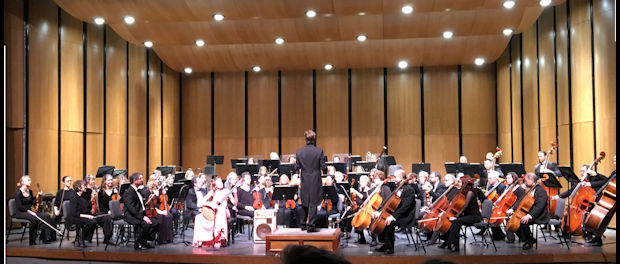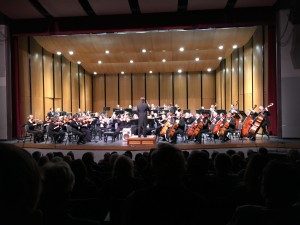RVS 2015-2016 Masterworks 4 Concert
 Guitarist Ana Vidović performing Rodrigo’s Concierto de Aranjuez with the Rogue Valley Symphony on Feb. 28, 2016 at Grants Pass Performing Arts Center, Grants Pass, OR
Guitarist Ana Vidović performing Rodrigo’s Concierto de Aranjuez with the Rogue Valley Symphony on Feb. 28, 2016 at Grants Pass Performing Arts Center, Grants Pass, OR
Exquisite Guitar Soloist Highlights RV Symphony’s Latest Concert Triumph
– by Lee Greene
Some time ago, I wrote that Music Director of the Rogue Valley Symphony, Martin Majkut, had “transformed . . . the orchestra into a top notch regional symphony orchestra, bringing high energy to the task of running the orchestra and it’s musicians, offering new pieces of music as well as a fresh outlook and insight into the standard classical repertoire, drawing quality musicians into the orchestra and “A” list soloists to join in its performances, and demonstrating an uncanny knack for assembling compelling and exciting concert programs.” [Chef Majkut Serves Up a Winning Feast as Rogue Valley Symphony Opens Its Season, Jacksonville Review, http://bit.ly/1rdQfYJ ] The question then, long since answered in the affirmative, was whether “he could keep it up”: continue to find ways to present “first rank major symphony company” quality concerts to the organization’s Southern Oregon audience. In the ensuing period of time, he has continued to raise the standard of excellence of the organization’s performances and its concerts, which I’ve had the occasion to repeatedly document in review after review. [See, e.g., Maestro Martin Majkut Ups the Ante Again With An Outstanding Concert to Open the RVS Season, http://bit.ly/1VLeIdJ; Rogue Valley Symphony’s Masterworks 2 Concert: Now Even Outperforming Major Metropolitan Orchestras, http://bit.ly/1RunuWY; Rogue Valley Symphony Masterworks Concert 3: A Celebration of Unsurpassed Beauty, http://bit.ly/1RVEvx7] Clearly, I am not imagining this, as I am not alone in my assessment of Dr. Majkut’s work with this orchestra; the League of American Orchestras recently named Maestro Majkut as one of its 2016 Emerging Artists conductors in recognition of what he is accomplishing with the Rogue Valley Symphony. [Emerging Artists 2016, Symphony Magazine, Winter 2016, p. 59, http://bit.ly/1YsmVks]
So it comes as no surprise that Dr. Majkut once again had the symphony performing at the top of its game during its most recent concert, 2015-16 Masterworks Concert 4 over the weekend of February 26-28, 2016. But the most notable takeaway from this latest outing of the Rogue Valley Symphony wasn’t the quality of the orchestra’s performance, which remains uncommonly top-notch, and surprisingly so for this market. Instead, what really made this concert special was the contribution of the latest “A” list soloist Maestro Majkut (with the assistance of his able cohort, Symphony Executive Director Jane Kenworthy, of course) managed to secure to collaborate with his orchestra for this concert, the exquisite classical guitar virtuoso, Ana Vidović. Also notable was the selection of pieces Dr. Majkut assembled for this latest compelling and exciting concert program.
Ms. Vidović is a Croatian virtuosa classical guitarist- a child prodigy who began playing guitar at the age of 5, was performing by the age of 8, performing internationally at the age of 11, and at age 13 became the youngest student to attend the prestigious Academy of Music in Zagreb where she studied with Professor Istvan Romer. [Wikipedia, Ana Vidović, http://bit.ly/1LQ9pFu] Her reputation as a guitar wunderkind got her an invitation to study at the Peabody Conservatory in Baltimore, MD, with Manuel Barrueco, from where she graduated in May 2003. [Ibid.] She has subsequently resided in the United States, while traveling around the world to maintain her international performance career. She has given over 1000 public performances since 1988. Ms. Vidović has won an impressive number of prizes and international competitions all over the world. These include first prizes in the Albert Augustine International Competition in Bath, England, the Fernando Sor competition in Rome, Italy, and the Francisco Tárrega competition in Benicasim, Spain. Other top prizes include the Eurovision Young Musicians competition, the Mauro Giuliani competition in Italy, the Printemps de la Guitare in Belgium, and the Young Concert Artists International Auditions in New York. And she’s still only a fetching young 35 years of age, with many more years of performances to look forward to. Having received some criticism (“sexist”, “politically incorrect”) when I commented favorably in a previous review about a violin soloist’s appearance, I want to be careful this time. Since the audience seemed to take notice and comment about Ms. Vidović ‘s appearance, I think it IS relevant for me to include that in an accurate report of the concert. But I will settle for quoting and vouching for the accuracy of a previous reviewer’s published observations:
“A lot has been said about Ana Vidovic’s looks, and I’m not going to go into that here at all, except to say that she is a stunning young woman, and carries herself well. She has great stage presence, and comes across as friendly, unassuming, charming, and warm. One thing of note was that she was using a footstool, wearing full “stiletto” heels! Most women can’t even walk in them – she played in them!’
[Bob Hansmann, review of the Ana Vidović performance at The Monkey club in New York, http://bit.ly/1peCFvU]
This was her second appearance with the Rogue Valley Symphony. While introducing her to the pre-concert lecture audience, Dr. Majkut gushed about her extensive and devoted fan base – there are Ana Vidović fans in this country who travel over 1000 miles just to attend a performance by her and hear her play live. As the Rogue Valley audiences discovered for themselves, it is worth the trouble.
For this concert, Maestro Majkut assembled a septet of Spanish-sounding works, basically a “Spanish” program, though the composers were not all Spaniards, but included Frenchman Bizet (Carmen Overture – Les Toréadors), and Russian Rimsky-Korsakov (Cappriccio espagnole), in addition to Spaniards, Joaquin Rodrigo (Concierto de Aranjuez), Federico Moreno Torroba (Sonatina), Francisco Tarrega (Recuerdos de la Alhambra) and Manuel de Falla (The Three Cornered Hat, Suites No. 1 and No. 2).

Rogue Valley Symphony performing Bizet’s Carmen Overture – Les Toréadors at the beginning of 2015-16 Masterworks Concert 4 on Feb. 28, 2016, at Grants Pass Performing Arts Center, Grants Pass, OR
As has become his signature habit, Dr. Majkut began the program with a crisp lively, but brief, opening piece, Bizet’s Carmen Overture – Les Toréadors. This piece set the tone for the concert (Spanish sounds), while giving all four sections of the orchestra (horns, strings, percussion and winds) a good workout, warming them up for what was to follow. The Symphony’s performance on this lively, upbeat and popular piece was immediate proof positive that Maestro Majkut was once again fully in charge of the orchestra and had them playing at the top level again,
That was followed by three pieces by Spanish composers, each of which calls for and showcases a skilled guitarist. So none of those would have been possible without the participation of Ms. Vidović. While the Rodrigo piece is a concerto for classical guitar and orchestra, the Torroba Sonatina and Tarrega Recuerdos de la Alhambra are solo pieces for guitar, added to the program because Ms. Vidović was performing in the concert, was willing to entertain the audience by playing a few additional pieces, and is so good that an opportunity like that is not one to be passed up.

Guitarist Ana Vidović performing Rodrigo’s Concierto de Aranjuez with the Rogue Valley Symphony on Feb. 28, 2016 at Grants Pass Performing Arts Center, Grants Pass, OR
When Ms. Vidović took the stage, the first work performed was the Rodrigo, pairing Ms. Vidović with the orchestra. The concerto was written in 1939 and “was inspired by the gardens at Palacio Real de Aranjuez, the spring resort palace and gardens built by Philip II in the last half of the 16th century and rebuilt in the middle of the 18th century by Ferdinand VI. The work attempts to transport the listener to another place and time through the evocation of the sounds of nature.” [Wikipedia, Concierto de Aranjuez, http://bit.ly/1Trd4vV] It is the best known of Rodrigo’s works, and much performed and quite well known, particularly the Second Movement , Adagio, of the three comprising the piece. The instrumentation of the piece is unusual and rare, particularly the second movement which “represents a dialogue between guitar and solo instruments (cor anglais, bassoon, oboe, horn etc.)” [Ibid.] While I have heard numerous recordings of the piece, particularly several featuring the great classical guitarist Pepe Romero, I have never heard it played better than by Ms. Vidović and the Rogue Valley Symphony at their third concert performance, on Sunday Feb. 28, 2016 at Grants Pass Performing Arts Center.
The piece begins with a guitar solo playing a Spanish dance rhythm, and right from the start it was clear that the audience was in for something special. The sounds Ms. Vidović produced from her guitar were exquisitely beautiful, the rhythms precise, the fingering nimble, the result magical, completely capturing the full and awed attention of the audience. The orchestra executed its responsibilities superlatively as well; Maestro Majkut had them well prepared to match and support Ms. Vidović. There were some terrific contributions by the violins and the cellos during the first movement, but in truth, the impressive guitar contribution outshined everything else. Similarly, in the second movement there were many fine contributions by the solo orchestra instruments, particularly English Horn (Kristin Kessler), but again all paled against the virtuosity of Ms. Vidović’s superb guitar playing. Repeating myself to be perfectly clear, it was without a doubt the best performance ever of Rodrigo’s Concierto de Aranjuez of the many I have heard, and on its conclusion was met with an enthusiastic, sustained, standing ovation from an appreciative crowd.
After the crowd settled down, Ms. Vidović got back to business again, performing the first of her two solo works, Torroba’s Sonatina. The Sonatina is one of the prolific Torroba’s earliest works (1924). Ms. Vidović has reputedly made the piece “one of [her] trademark works”. [Bob Hansmann, review of the Ana Vidović performance at The Monkey club in New York, http://bit.ly/1peCFvU] In the words of that earlier reviewer, “In her hands it came to life!” [Ibid.] I’ll second that! Once again, Ms. Vidović’s performance was exquisite. Proving beyond a doubt that music does not have to be loud and emphatic to have a powerful impact, Ms. Vidović was deliberate, but agile and soft in fingering most of this piece. The result was one of the most relaxing, soothing, appealing pieces of music one can imagine. “Priceless”, as they say in the popular credit card ads. I greatly regret that I cannot present an excerpt clip of that Grants Pass performance (while I AM permitted to make recordings at Rogue Valley Symphony concerts, I am NOT allowed to record anything when a guest soloist is playing – too many complications with agents, management companies, sensitive protective artists, etc.). But I feel compelled to do the next best thing and provide readers with a publicly available recording of an earlier performance (April 2015) of Torroba’s Sonatina by Ms. Vidović, so those who couldn’t be at one of the three Rogue Valley Symphony concerts can get a sense of what they missed. If anything Ms. Vidović just seems to get better and better, so the Grants Pass performance of the piece was at least the equal of this recorded one.
The audience barely had enough time to soak in the exquisite beauty of Ms. Vidović’s Torroba Sonatina performance and respond with another sustained standing ovation before she was back on the stage to perform her second solo piece, Tarrega’s Recuerdos de la Alhambra. Recuerdos de la Alhambra was composed by Tarrega in 1896. It is another work that has been oft recorded and also used as incidental music in other contexts (such as in an episode of the HBO series, The Sopranos). The piece showcases the challenging guitar technique performed by advanced players “known as tremolo, wherein a single melody note is plucked consecutively by the ring, middle and index fingers in such rapid succession that the result is an illusion of one long sustained note. The thumb plays a counter-melody on the bass between melodic attacks. Many who know this piece only as a recording mistake it for a duet rather than a challenging solo effort, but any student of classical or Spanish guitar will immediately realise that it can – and therefore must – be played by one hand.” [Wikipedia, Recuerdos de la Alhambra, http://bit.ly/1LPTeYK] When it is well done, it is downright impressive: a piece where one artist’s one hand plays what sounds like a duet. And again, I have never heard it done better than by Ana Vidović on that Grants Pass stage. Bottom line: Maestro Majkut not only has raised the bar of the quality of the performances of the Rogue Valley Symphony to equal that of major metropolitan orchestras, but also raised the bar of the quality of soloists joining in their concerts: Ana Vidović is at least a “AAA” soloist. And the concert was only half over – Ms. Vidović’s Tarrega performance was followed by an intermission and then the Rogue Valley Symphony took the stage to perform three more pieces.
After the intermission, the orchestra returned to the stage and played, in order, Manuel de Falla’s The Three Cornered Hat, Suite No. 1 followed by The Three Cornered Hat, Suite No. 2. The two Suites present most of the music from a ballet collaboration between de Falla and Russian ballet impresario Sergei Diaghilev, which debuted in London in 1919 and was an adaptation of the 1875 novel El sombrero de tres picos by Pedro Antonio de Alarcón. The ballet is somewhat unusual in utilizing Spanish dance rather than classical ballet, set to traditional Andalusian folk music. It’s as Spanish sounding as Spanish sounding classical music gets, and once again, the Rogue Valley Symphony with Maestro Majkut at the helm, acquitted itself well – the audience heard a wonderful performance of this Spanish sounding work, with a variety of impressive solos (bassoon, horn, etc.) and everyone seemingly at the top of their game. Rather than spend more time and ink writing about it, this time I CAN give you an excerpt clip from the Grants Pass concert, so you can hear it for yourself and form your own opinion. Here’s the final two minutes of the Finale movement (Jota) of The Three Cornered Hat, Suite No. 2:
https://youtu.be/8F-Y69it5jI
Which brings us to the last, but by no means the least, piece on the program, Cappriccio espagnole by Russian composer Rimsky-Korsakov. Cappriccio espagnole is a 16 minute five movement orchestral suite, based on Spanish folk melodies, composed by Rimsky-Korsakov in 1887. [Wikipedia, Capriccio Espagnol, http://bit.ly/1R53g4l] The piece has been much praised by critics over the years, especially for its unique articulations, such as in the fourth movement where string players are directed to imitate guitars (violin and viola parts are marked “quasi guitara”). [Ibid.] But possibly the best description of Cappriccio espagnole was supplied by the composer himself, in his autobiography:
“The Capriccio is a brilliant composition for the orchestra. The change of timbres, the felicitous choice of melodic designs and figuration patterns, exactly suiting each kind of instrument, brief virtuoso cadenzas for instruments solo, the rhythm of the percussion instruments, etc., constitute here the very essence of the composition and not its garb or orchestration. The Spanish themes, of dance character, furnished me with rich material for putting in use multiform orchestral effects. All in all, the Capriccio is undoubtedly a purely external piece, but vividly brilliant for all that.” [Ibid.]
Rimksy-Korsakov indeed brilliantly uses all the sections of the orchestra and gives each a moment in the limelight, a time to shine. Almost every section gets solos and cadenzas: horn, trumpets, violins, flute, clarinet, harp. And Maestro Majkut had the orchestra’s musicians playing superbly, positively showing off their prowess, individually and collectively. It was a musical very apt strutting of their stuff and quite the perfect ending to this concert: exciting Spanish sounding music at its very best! And here is an excerpt presenting the ultimate conclusion to this magnificent concert, the last two minutes of the 5th (and final) movement of Cappriccio espagnole (Fandango asturiano):
https://youtu.be/IIVydFspMvA
You’re welcome! For those who have not been fortunate enough to attend one of these extraordinary concerts by the Rogue Valley Symphony, there is still one set of concert performances remaining on the 2015-2016 season: the 2015-16 Masterworks 5 Concert will feature a return performance by prominent International concert pianist, Alexander Schimpf, who previously joined the Rogue Valley Symphony for their January 2013 concerts. For 2015-16 Masterworks 5 Concert, Mr. Schimpf will be performing Brahms’ Piano Concerto No. 2 with the Symphony, which will also be performing Mendelssohn’s The Hebrides and Debussy’s La Mer on the program. Performances are scheduled on April 22, 2016 at S.O.U. Music Recital Hall in Ashland, April 23 at the Craterian Theatre in Medford, and April 24 at Grants Pass Performing Arts Center. Tickets can be obtained by calling 541-552-6398 or online at http://bit.ly/1W5AS5g.





